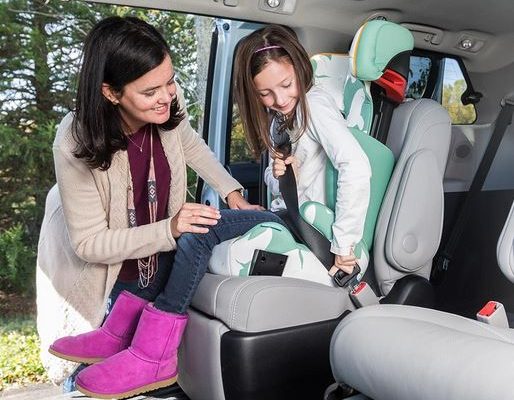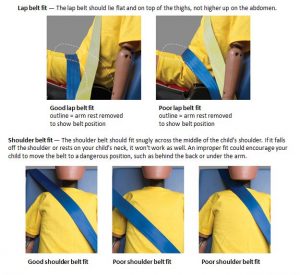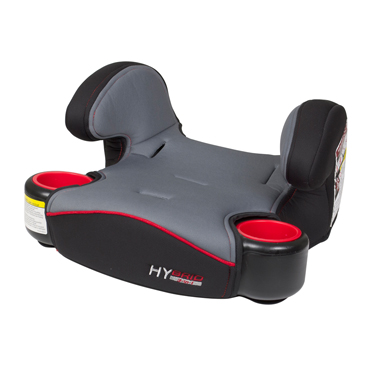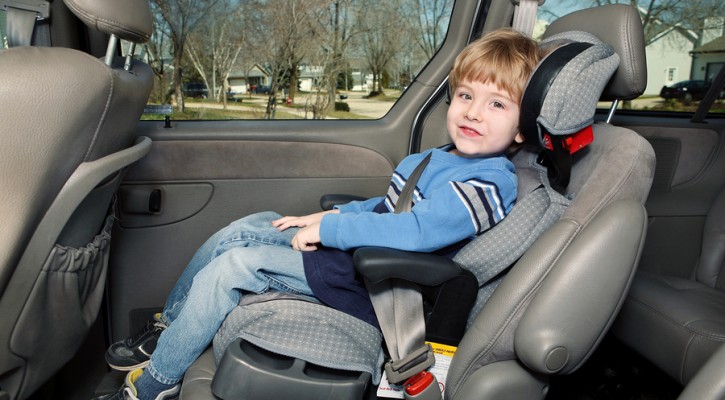Tag Archive: booster seats

IIHS: List Of Top Child Booster Seats for 2016
November 18, 2016
If you’re a parent whose child is ready to graduate to a booster seat or a grandparent looking for the perfect Christmas gift to ensure your grandchild’s safety, the Insurance Institute for Highway Safety (IIHS) has come out with a new list of the top booster seats just in time for the Christmas shopping season
It seems that manufacturers have gotten the hint and, compared to only 25% of the seats getting a good rating in 2008, this year, 48 out of 53 new models got a best bet rating. A best bet rating means they are likely to provide good belt fit for a four to eight year old child in almost any car, minivan, or SUV.
Out of the 53 seat models tested, three seats are rated “Check Fit” meaning they may not provide the best belt fit in all makes of vehicles. Two seats, the Cosco Easy Elite and the Cosco Highback 2-in-1 DX — both made by Dorel — were rated “Not Recommended.”

Click on image to enlarge
Parents should remember that, in spite of some state laws, booster seats are recommended for children once they outgrow their child seat, at approximately age four, until they’re big enough for a seat belt to fit properly, low on their hips, without riding up over their abdomen. For the average child that can be anywhere from nine to twelve years of age.
Another thing to remember is that child seats have an expiration date. Sunshine and trapped heat inside a car over long periods of time can degrade the plastics and synthetic fabrics used in the seat structure and belts. If you’re considering using a hand-me-down seat, you’ll want to check the expiration date located underneath the seat.
For more information, visit: Designs that click – Booster manufacturers have mastered good belt fit
Images courtesy: Insurance Institute for Highway Safety

Insurance Institute Lists Best Booster Seats
November 10, 2014
The Insurance Institute for Highway Safety (IIHS) has come out with their list of best booster seats for 2014. To test the booster seats, the IIHS uses a special test dummy that represents the average six year old under a range of conditions that test for proper fit and placement under a range of different seat belt configurations.
When selecting a booster seat for your child, the key item to look for is proper fit and placement of the seat belts. Seat belts aren’t really designed for children and can ride up over the soft tissue of the abdomen instead of riding low over the hips. An improperly fitted seat belt could harm the child in a crash. Booster seats are designed to raise the child up so that the seat belt fits properly over the upper thighs and the shoulder harness rests over the center of the shoulder.
In assigning a “best bet” rating to a booster seat, the IIHS has determined that the booster seat will perform well on the typical four to eight year old in a variety of vehicles and seat belt configurations.
In checking with various retailers, the best bet seats range in price anywhere from under $25 to more than $200. For more information on testing procedures, proper fitting and the list of the top rated booster seats, visit: Booster evaluations for 2014
Photo compliments of: babytrend.com

Kids In Cars Put In Danger By Parents
September 16, 2014
One in five parents put kids in cars in danger by “bending the rules” according to a survey conducted by Safe Kids Worldwide and funded by the General Motors Foundation. In the online survey, parents admitted that, when carpooling, they sometimes bent the rules by allowing kids to ride without a booster seat or even without seat belts.
According to Safe Kids, “Sixty-one percent of parents say they notice other carpool drivers bending the rules. Safe Kids research also shows that one in four parents report they don’t buckle up their children on every ride.”
Even on a short trip, the dangers of a crash are high. Most car crashes happen within 25 miles of home and at speeds under 45 mph. The reason for that is simple; your chances of being involved in a crash close to home are greater because that’s where you drive most often.
School age children should be belted into a booster seat seat until they are big enough to wear a seat belt properly. Safety experts say that kids should remain in a booster seat until they are at least 4’7” tall and weigh between 80 and 100 pounds. For most kids that’s between 9 and 11 years of age.
According to the National Highway Transportation Safety Administration (NHTSA), motor vehicle crashes were the leading cause of death for children age 4 and every age 11 through 14. They are the second leading cause of death for ages 5 through 10. NHTSA data shows that, “among passenger vehicle occupants 5 and older, seat belts saved an estimated 12,174 lives in 2012. If all passenger vehicle occupants 5 and older had worn seat belts, 15,205 lives (that is, an additional 3,031) could have been saved in 2012.”
Even on short trips, kids in cars need to be buckled into a child safety seat appropriate for their age. Parents who carpool should never take more children than the number of seat belts available in the vehicle. Carpooling parents should also arrange to swap out car seats and booster seats.
Don’t place yourself in the position of a parent who says “If only I had….”
For more information, read: STUDY REVEALS 9 OUT OF 10 PARENTS MOVE THEIR CHILD FROM BOOSTER SEAT TO SEAT BELT BEFORE THEIR CHILD IS BIG ENOUGH

Child Passenger Safety Week Sept. 14-20
September 15, 2014
This is National Child Passenger Safety Week and it’s a good time to remind parents or those who care for children, about the proper way to care for a child while driving. When it comes to child safety seats, one size doesn’t fit all and it’s important to understand how to choose and install the proper child seat according to your child’s age.
According to a survey by the National Highway Transportation Safety Administration (NHTSA), these are the most common mistakes made by parents when installing and using child safety seats and booster seats:
- Wrong harness slot used – The harness straps used to hold the child in the car seat were positioned either too low or too high;
- Harness chest clip positioned over the abdomen rather than the chest or not used at all;
- Loose car seat installation – The restraint system moved more than two inches side-to-side or front to back; anything more than one inch is too much.
- Loose harness – More than two inches of total slack between the child and the harness strap; there should be no slack.
- Seat belt placement was wrong – Lap belt resting over the stomach and/or shoulder belt on the child’s neck or face.
Both NHTSA and SafeKids recommend the following steps listed on the Safe Kids downloadable checklist:
- Right Seat. Check the label on your car seat to make sure it’s appropriate for your child’s age, weight and height.
- Right Place. Kids are VIPs, just ask them. We know all VIPs ride in the back seat, so keep all children in the back seat until they are 13. Doing this, along with correctly using the appropriate child restraints, greatly reduces the risk of injury.
- Right Direction. You want to keep your child in a rear-facing car seat for as long as possible. When he or she outgrows the seat, move your child to a forward-facing car seat. Make sure to attach the top tether after you tighten and lock the seat belt or lower anchors.
- Inch Test. Once your car seat is installed, give it a good shake at the base. Can you move it more than an inch side to side or front to back? A properly installed seat will not move more than an inch.
- Pinch Test. Make sure the harness is tightly buckled and coming from the correct slots (check manual). Now, with the chest clip placed at armpit level, pinch the strap at your child’s shoulder. If you are unable to pinch any excess webbing, you’re good to go.
Many parents don’t realize that child safety seats have an expiration date. The plastic and synthetic materials used to make the seat’s body and straps can break down over time when exposed to the high heat and sunshine in a parked car. It’s not a good idea to use a hand-me-down car seat for younger children.
There are several good websites that provide information on the proper selection, installation and care of child safety seats. For information about:
- Advice on child safety in and around cars, visit the Insurance Institute for Highway Safety (IIHS): http://www.iihs.org/iihs/brochures/keeping-children-safe
- IIHS ratings on booster seats, visit: http://www.iihs.org/iihs/ratings/child-boosters
- Where to find a car safety seat inspection station near you, visit: http://www.seatcheck.org/
- Child safety seat laws in your state: http://www.iihs.org/iihs/topics/laws/safetybeltuse?topicName=child-safety

Florida Law Requiring Booster Seats For Children Under 5 Inadequate!
June 30, 2014
On June 24, 2014, Florida’s governor, Rick Scott signed HB 225 into law requiring that all children under the age of 5 are required to be placed in a federally approved car safety seat or booster seat. While the law is better than the old law that allowed children over the age of four to graduate to seat belts, it still doesn’t go far enough.
To look at why the legislation isn’t enough we have to look at how seat belts work to restrain a body in a crash. If properly worn, low over the hips, a seat belt works in a crash by pushing against the hip bones. The shoulder harness works by pushing against the breast bone and shoulder bone. If the lap belt is worn too high, over the abdomen instead of low on the hips, it can cut through the soft tissue of the abdomen in a violent crash. The problem with children is that their frames are too small and narrow for the lap belt to remain low over the hips and they often ride up over the abdomen, leading to injuries in a crash.
A seat belt is better than nothing at all because the alternative in a crash would be for the child’s body to fly forward and crash into the front seat or impact multiple points within the vehicle. In violent crashes, the child’s body can be thrown out of the vehicle and strike the road surface so seat belts are always preferable to no protection at all.
The Insurance Institute for Highway Safety (IIHS) has looked at crash data and recommends that children, once they have graduated out of a child protective seat, graduate to booster seats and remain in those booster seats until they are at least 4’9” tall. For the average child, that is anywhere from 9 to 11 years of age. The booster seat works by raising the body so that the seat belt rides low over the hips, providing maximum protection in a crash. Many states have adopted the IIHS recommendations and mandated booster seats for children until they are at least 4’9” or 9 years of age.
Regardless of what the Florida law may say, parents should maximize protection for their children and keep them in booster seats until they reach the 4’9” height. For more information on child protective seats and choosing the right seat for your child, visit the IIHS website at: http://www.iihs.org/iihs/topics/t/child-safety/topicoverview
